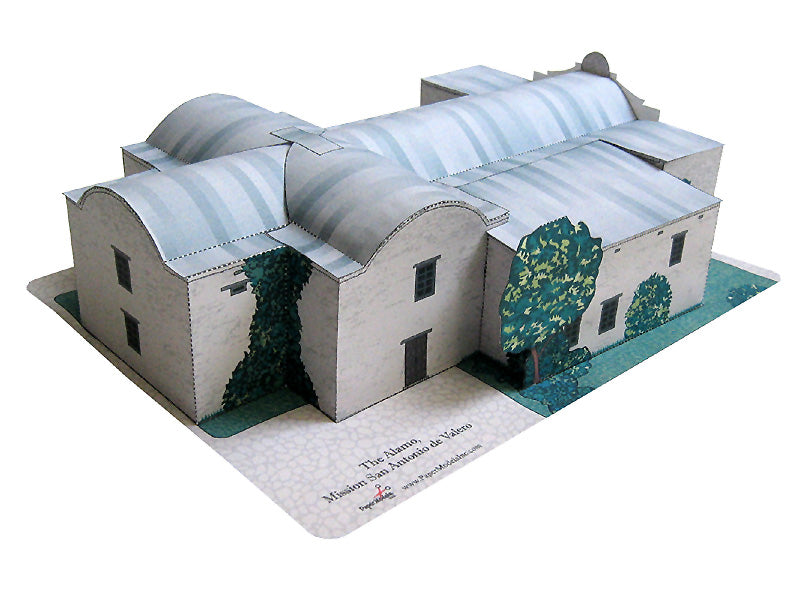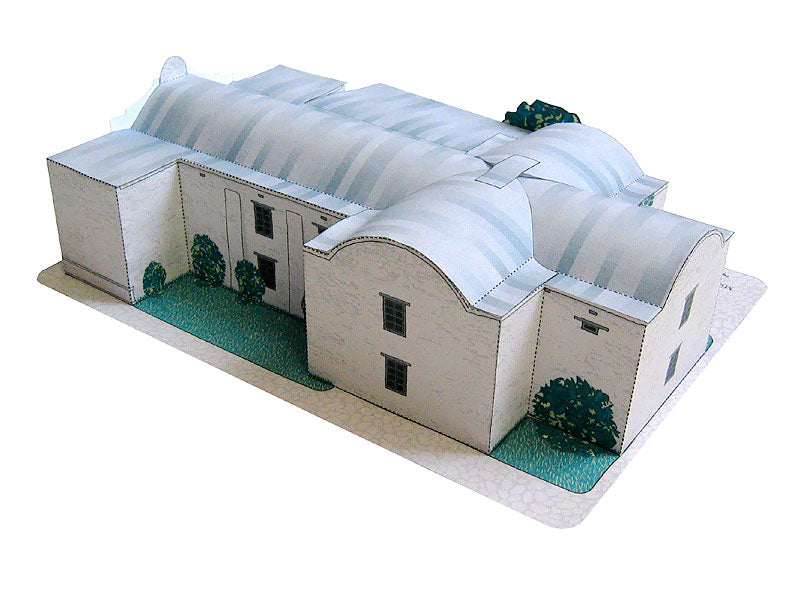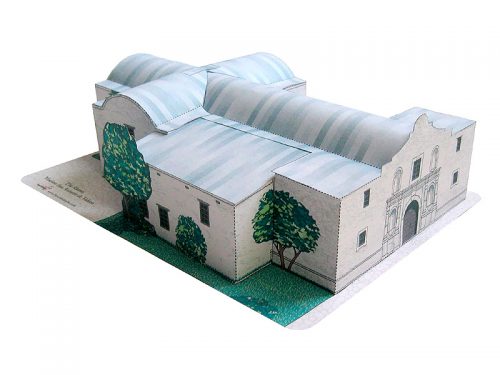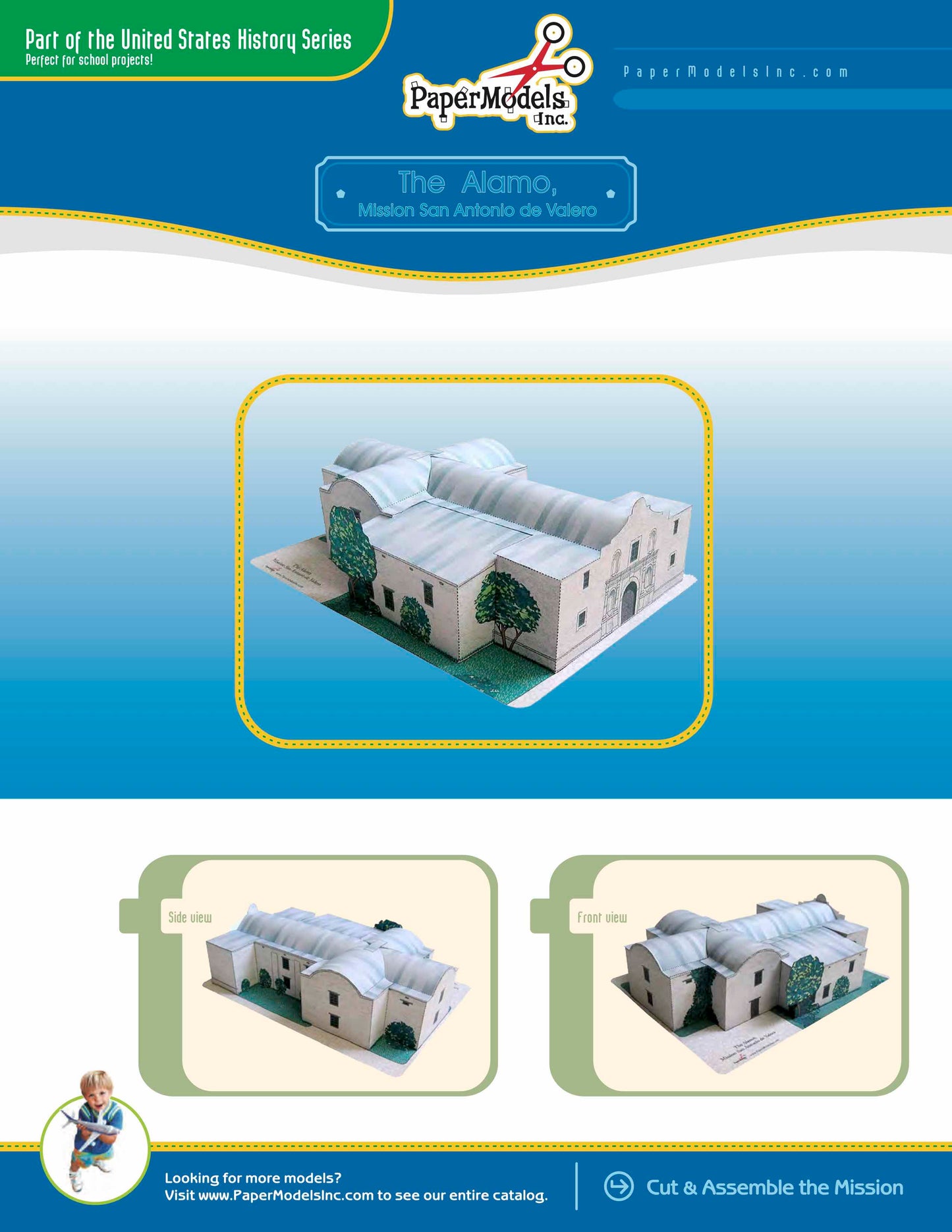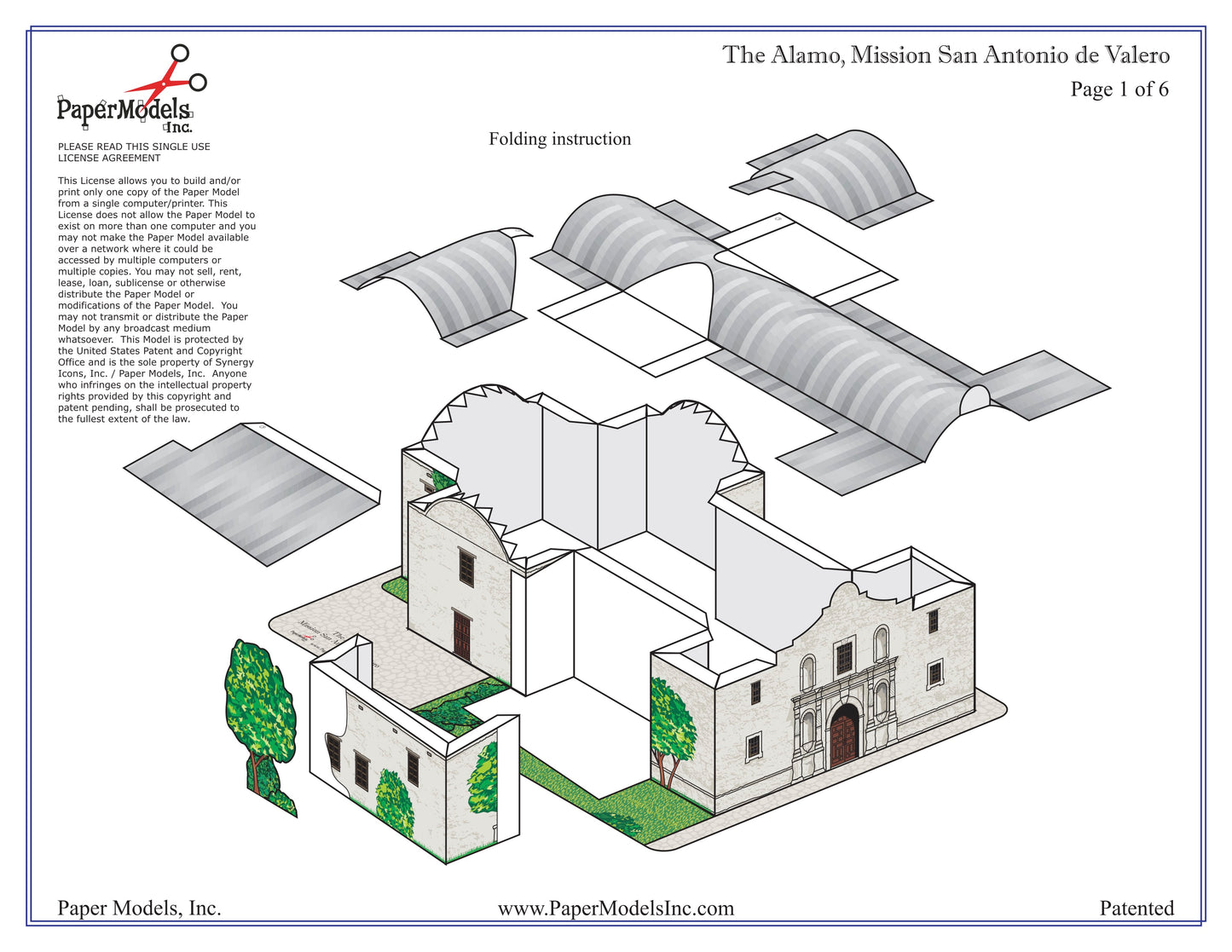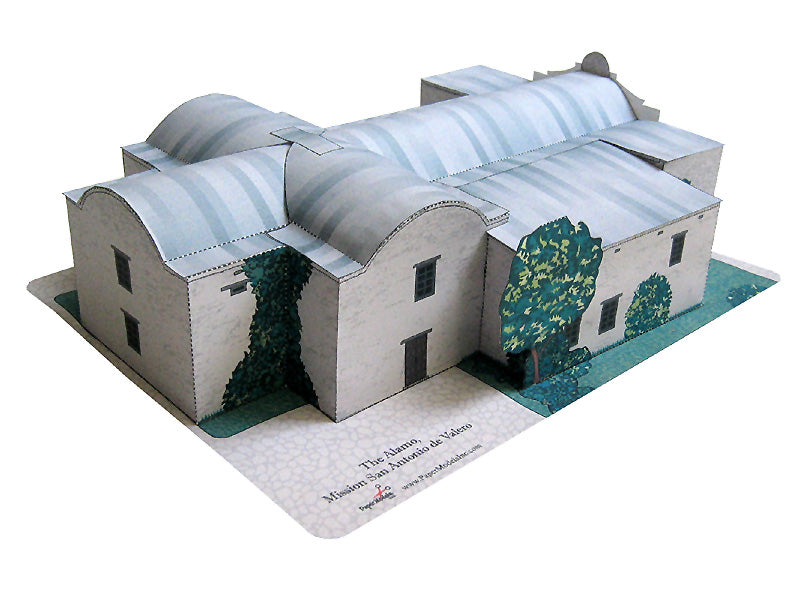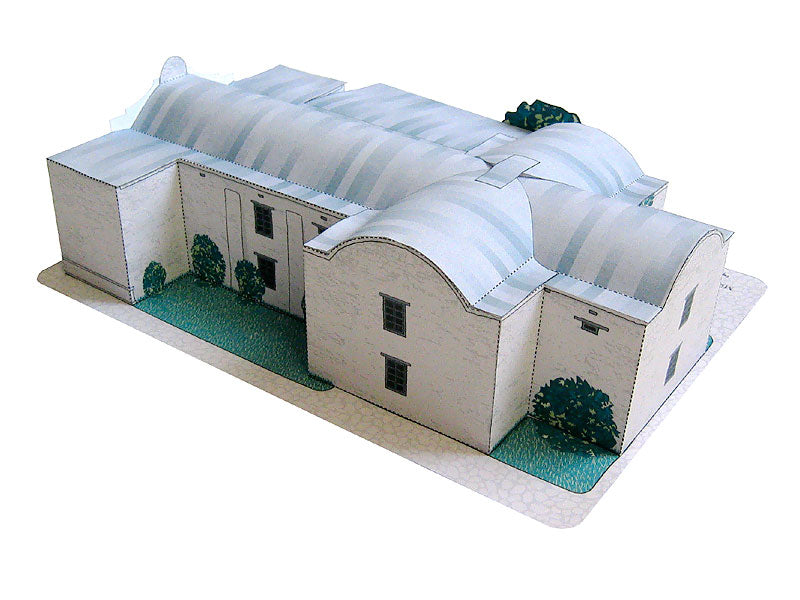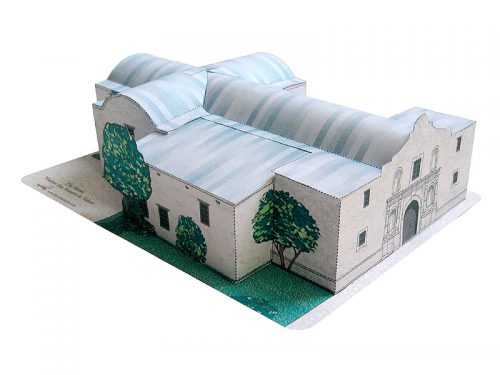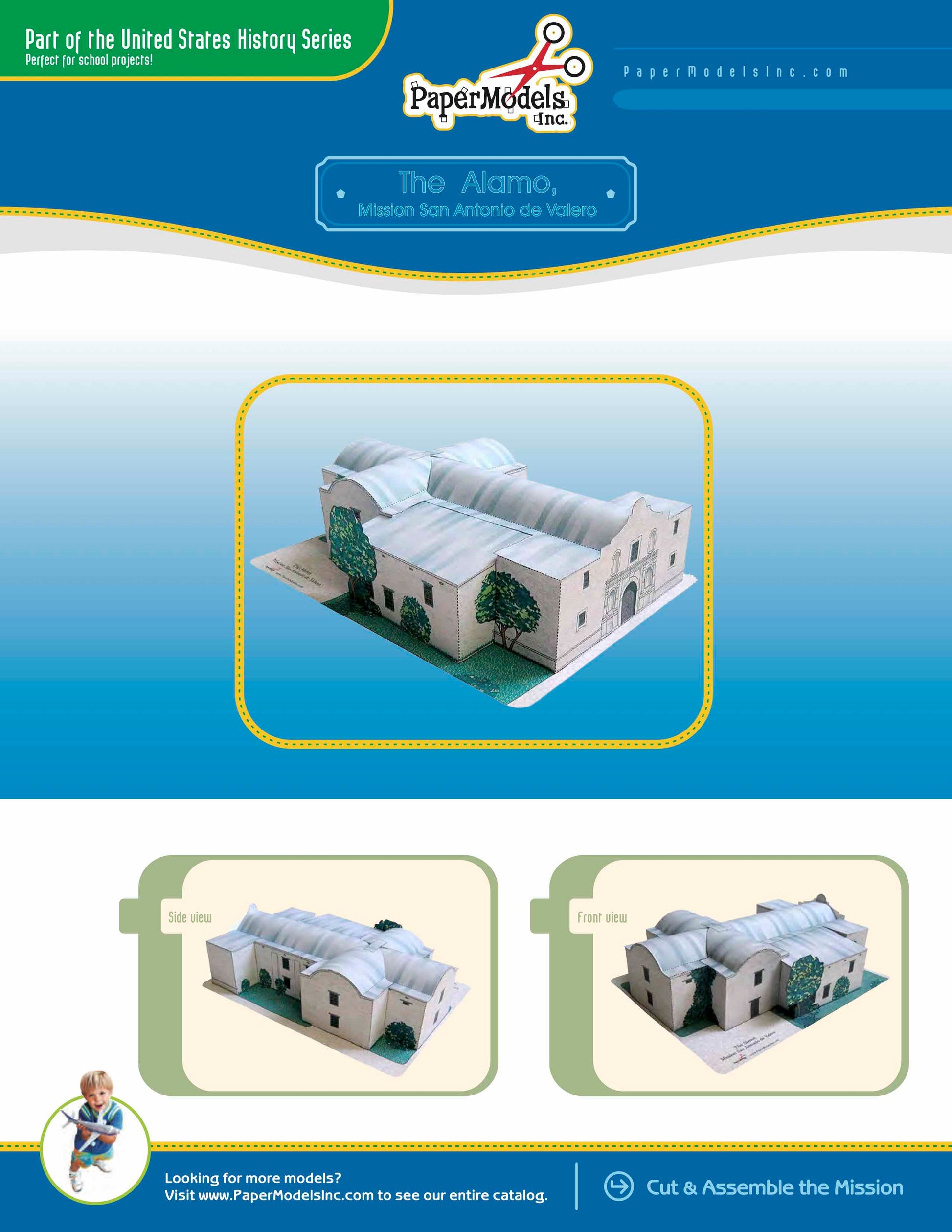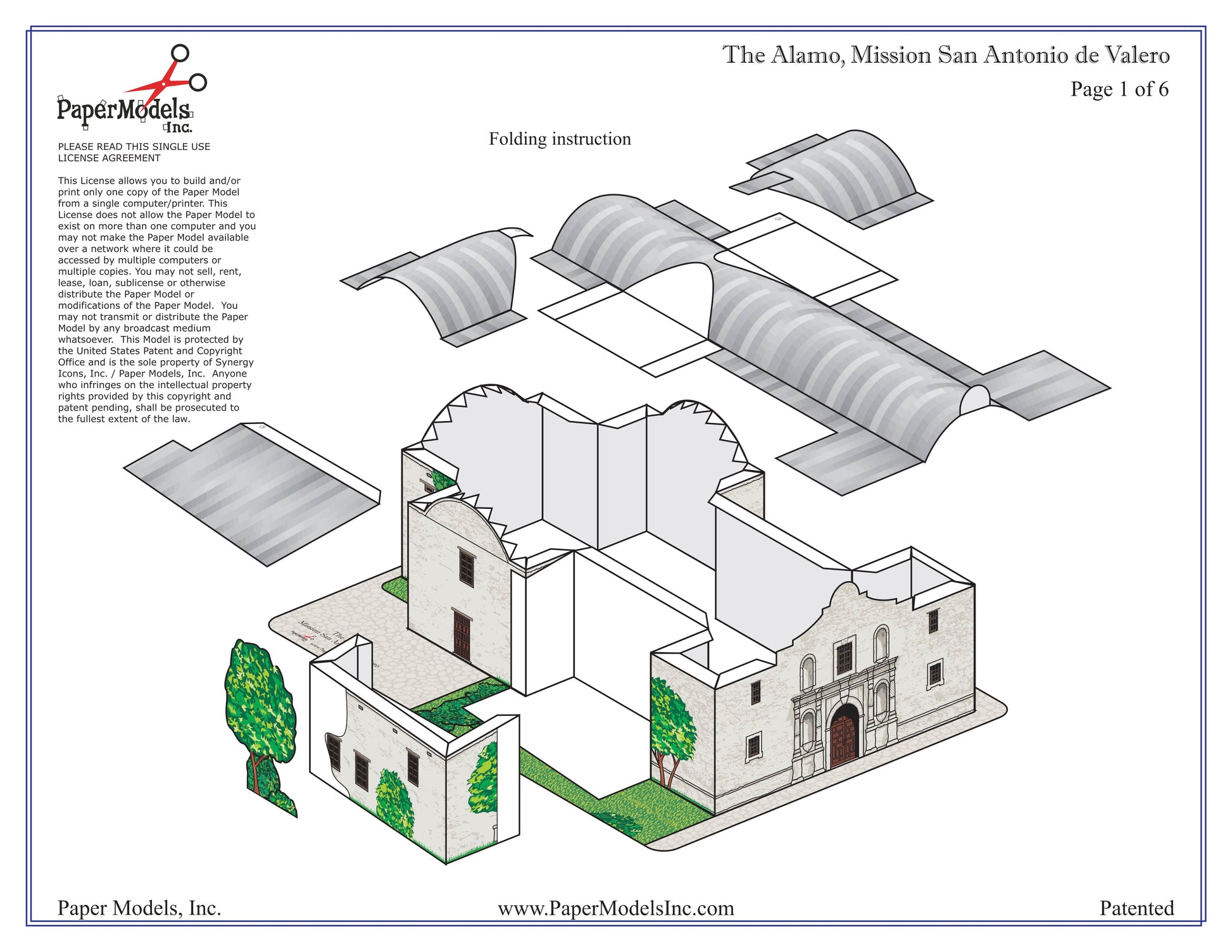Alamo - San Antonio, TX - Paper Model Kit
Alamo - San Antonio, TX - Paper Model Kit
No se pudo cargar la disponibilidad de retiro
🌟 Welcome to Paper Models Online – Your Shortcut to Academic Excellence! 🌟
Are you tired of stressing over last-minute school projects? Look no further! Paper Models Online is here to make your academic life a breeze.
🚀 Why Choose Us?
At Paper Models Online, we understand the pressure of looming deadlines and the desire for that coveted "A" grade. That's why we've crafted the perfect solution for you! Whether you're a student aiming for extra credit, a parent looking for quality time with your kids, or just someone in need of a break from the chaos, our paper models are your ticket to success!
💻 Instant PDF Download OR Pre-Printed & Shipped
You're in control! Choose from our instant PDF download, starting at just $9.95 for the 7"x10" size or $11.95 for the 10"x13" size.
Print it on your home or office printer using regular paper, or opt for the hassle-free pre-printed option. We'll ship it directly to your doorstep for a flat $5 fee via USPS First-Class Parcel, ensuring you get it in 1-3 days!
✂️ Easy Assembly, Maximum Impact
With just a pair of scissors, some glue, and an hour of your time, you can turn these paper sheets into stunning three-dimensional architectural replicas or complete science projects. The images on our website are real models made from our kits, and we even provide a history to help you craft an impressive report.
🎨 Unleash Your Creativity
Not into mission kits? No worries! Our models double as templates for your creative genius. Paint, trace, adjust sizes—your imagination is the only limit! Create a custom masterpiece that reflects your unique style and personality.
🛒 The Buying Process Made Simple
- Choose Your Size: 7"x10" or 10"x13"
- Choose Your Delivery: Instant PDF download or pre-printed and shipped
- Purchase Your Model: It's that easy!

📦 Typical Kit Sample
Each kit includes 8 to 18 pages, providing everything you need to bring the model to life. An "exploded view" guides you through assembly, and a complimentary history adds that extra touch for your report. Impress your teacher not just with creativity but also with your research skills!
Don't let deadlines stress you out. Choose Paper Models Online for your next school project, and let us be Your Best Way To Get An "A"! 🌟
 |
 |
 |
| Exploded View | Sample Pieces | Finished Model |
The Alamo History
1716 - The Viceroy of New Spain, the Marqués de Valero, authorizes the relocation of the Mission of San Francisco Solano from the Rio Grande to the San Antonio River.
1718 - Mission San Antonio de Valero is founded by Franciscan missionaries from the College of Querétaro, led by Antonio de San Buenaventura Olivares. The site chosen for the mission is on San Pedro Creek, west of the San Antonio River. Formal ceremonies are performed by Governor of Coahuila and Texas, Martín de Alarcón. The area is frequented by numerous native bands and tribes whose members are recruited as Christian converts and settlers by the missionaries.
1719 - The mission is moved to the east side of the River.
1720 - A second mission, San José y San Miguel de Aguayo is established on the San Antonio River, south of San Antonio de Valero.
1724 - Following a severe storm, San Antonio de Valero is moved a short distance north, to its final site.
1731 - Three missions in East Texas, Nuestra Senora Purísima Concepción de Acuña, San Juan Capistrano, and San Francisco de la Espada, are moved to the San Antonio River. A group of settlers from the Canary Islands arrives to form a new civil settlement, San Fernando de Béxar. 1744 - A cornerstone is laid for a church at San Antonio de Valero. Church construction continues for several years.
1793 - On the order of the King of Spain, San Antonio de Valero Mission is secularized, its ranch properties distributed among the civilian population.
1801 - Irish-American trader Philip Nolan, leader of several past expeditions to Spanish territory, enters northeast Texas to hunt for wild horses. Spanish troops sent from Nacogdoches to capture Nolan and his followers engage them in battle, in which Nolan is killed. The survivors are marched to San Antonio, where they are held for three months before being transported to Chihuahua and imprisonment.
1803 - The mission property is used as military post. The arrival of the Second Company of San Carlos de Parras from the vicinity of the town of El Alamo in Coahuila is the possible source for the popular name of the former mission. A church parish is established and the remains of the church are used for services for soldiers at the post.
1806 - Part of mission is reconditioned for use as a military hospital.
1807 - Zebulon Pike, arrested by Spanish authorities near the headwaters of the Rio Grande, is cordially received in San Antonio by the Governor. Pike later reported that the town was laid out on a "grand plan," and noted the "station of the troops"-the Alamo-east of the river.
1811 - Soon after the initiation of the Mexican independence movement, factions in San Antonio become involved in the struggle. Juan Bautista de las Casas takes control of local troops, seizes government officials, and proclaims allegiance to the independence cause of Father Miguel de Hidalgo y Costilla. The success of the uprising is short-lived; just over a month later, loyalist residents under Juan Manuel Zambrano retake San Antonio for the King. Las Casas and other leaders of the insurrection are tried and executed.
1813 - A filibustering army under Mexican native José Bernardo Gutiérrez de Lara and former U.S. Army officer Augustus Magee enters Texas from Louisiana, and advances toward San Antonio. After defeating Royalist troops outside the town, San Antonio is taken by the rebel army. Spanish governor Manuel Salcedo and other officials are executed. The victorious Gutiérrez declares Texas' independence, and drafts a constitution, though he is soon forced from power and removed from the province. Again, the revolutionary triumph is fleeting; a Royal force under José Joaquin Arredando crushes the republican army at the Medina River, and recaptures San Antonio. The years of fighting leave San Antonio depopulated and economically devastated.
1817 - Francisco Xavier Mina launches a military expedition against Mexico from Galveston Island.
1818 - The Champs d'Asile colony is organized on the Trinity River by French exiles, but is soon abandoned.
1819 - San Antonio is damaged by a flood of San Pedro Creek.
1821 - The Plan of Iguala assures Mexican independence. In July, San Antonio officials swear allegiance to the new, independent nation of Mexico. Carrying out his father's plan, Stephen F. Austin brings his first colonists to Texas.
1823 - Agustín Iturbide abdicates as Emperor of Mexico. Mexican leaders soon begin work on a national constitution.
1824 - Under the new constitutional government, Coahuila y Texas becomes a single state, with the capital in Saltillo.
1825 - Texas becomes a department under state government, with a political chief residing in San Antonio.
1826 - The Republic of Fredonia is declared in Nacogdoches; failing to obtain broad support, its organizers flee Texas.
1830 - Alarmed by the growth in numbers of colonists from the United States, the Mexican government seeks to slow immigration into Texas from the north, while introducing more new residents from Mexico and Europe. On April 6, a law passed by the Mexican Congress prohibits settlement in Texas by immigrants from the United States, and cancels all colonization contracts. Although repealed in 1833, this article remains a sore point with the growing immigrant population.
1832 - June - The Turtle Bayou Resolutions are adopted by colonists, accusing the Mexican government of constitutional violations. October - A convention meeting at San Felipe de Austin draws up a list of grievances against the government. San Antonio officials decline to participate, but leading citizens of the town later protest the colonization law.
1833 - A second convention at San Felipe de Austin proposes more changes in government; Stephen F. Austin presents its resolutions in Mexico. The government of new president Antonio Lopez de Santa Anna responds to the complaints, reorganizing local government and granting Texas greater representation in the state legislature.
1835 - October - The refusal of Gonzales residents to return a cannon to the Mexican army leads to an exchange of gunfire. In response, Santa Anna sends troops under Martin Perfecto de Cos to San Antonio. The Alamo becomes part of the defenses of the city. October-December
Led by Austin, an army of untrained and often unruly settlers lay siege to the Mexican army, which held positions in the Alamo and the plazas of the town. The Texan forces were victorious in a skirmish near Concepción mission, and in the "Grass Fight," but the siege dragged on into November with no agreement on how to proceed. Called to serve as a commissioner to the United States, Austin leaves San Antonio in November, and opinion is divided on how to proceed until Ben Milam rallies the force to an attack on December 5. After five days of fighting, during which Milam is killed, the Battle of Bexar concludes with the surrender of Mexican forces. Cos agrees to withdraw to the south, leaving Texas under the control of the rebel army.
1836 - February 3 - William Barret Travis and a small group of reinforcements arrive at the Alamo, then under the command of James C. Neill.
1836 - February 8 - Former Tennessee congressman David Crockett arrives at the Alamo with a group of volunteers.
February 12 - With the departure of Neill, Travis is elected commander of the regular army forces at the Alamo, while Jim Bowie is chosen to lead the volunteers.
February 23 - The Mexican army under Antonio López de Santa Anna reaches San Antonio. The Texian force retreats into the walled Alamo compound.
March 1- Thirty-two men from Gonzales join the besieged forces at the Alamo.
March 2 - Texas Declaration of Independence is approved by delegates meeting at Washington- on-the-Brazos.
March 6 - The attack upon the fortified Alamo begins before dawn. When the fighting ends, all of its occupants other than women, children, and Travis' slave Joe, are dead. Losses to the attacking Mexican army are estimated to be at least 600.
March 20 - Following a battle near Coleto Creek, the Texian force led by James W. Fannin is captured.
March 27 - On the order of General Santa Anna, Fannin and a force of almost 350 men are executed at Goliad.
April 21 - After retreating eastward for more than a month, the Texian Army defeats the larger Mexican force at the Battle of San Jacinto, capturing General Santa Anna and securing Texas' independence.
May 14 - The Treaties of Velasco are signed by Santa Anna, promising the cessation of hostilities and the withdrawal of Mexican troops to below the Rio Grande.
September - The Constitution of the Republic of Texas is approved by vote; Sam Houston is elected president.
October - First Congress of the Republic of Texas convenes.
November - Santa Anna is released by the Texians and travels to Washington to meet with United States officials.
1837 February - Colonel Juan Nepomuceno Seguín, military commander at San Antonio, presides over the burial of the ashes of the defenders of the Alamo. The battered mission and fortress then stood virtually abandoned, a symbol of the brief but bloody struggle. San Antonio is incorporated and Bexar County is created.
1840 - The frontier town of Austin is chosen as the capital of Texas. Negotiations in San Antonio between the Texas government and Comanche leaders erupt into violence when the Texans attempt to take the Comanche into custody, resulting in over 40 deaths.
1841 - The Santa Fe expedition sets out from the Austin area on an ill- fated mission to extend
Texas' economic and political influence into New Mexico. The Republic of Texas concludes that the Church of the Alamo and any mission outbuildings belong to the Catholic Church.
1842 September - San Antonio is briefly occupied by Mexican troops and several local men are taken prisoner. Forces from San Antonio and Gonzales engage the invading army at the Battle of Salado.
November-December - The Somervell and Mier expeditions into Mexico are organized. 1845 The annexation of Texas is approved by Congress in December.
1846 - Texas formally joins the United States on February 19. The U.S. Government occupies the Alamo, using it as a quartermaster and commissary depot, under a lease from the Catholic Church. The buildings are repaired and renovated, the now-familiar facade added to the church in 1850, along with a new roof.
1847 - Alamo Lodge No. 44, the first Masonic lodge in San Antonio, is organized at a meeting in the second story of the Alamo convento. Eight charter members are led by Captain James H. Ralston, Assistant Quartermaster for the recently-arrived U.S. Army.
1850 - The City of San Antonio files suit against Bishop John Odin and Maj. E.B. Babbitt, seeking the title to the Alamo property. A verdict is returned in favor of the defendant, finding the church's claim to the site is valid. The decision is upheld on appeal to Texas Supreme Court in 1855.
1861 - Texas secedes from the Union and joins the Confederate States of America. The Confederate army takes over military facilities at the Alamo with the withdrawal of U.S. troops. 1862 - A battle begins New Year's eve which results in the recapture of Galveston by Confederate forces.
1863 - An attempted invasion of Texas at Sabine Pass is repulsed by Confederate forces.
1865 - The last land battle of the Civil War is fought near Brownsville in May. The U.S. Army resumes use of the Alamo.
1871 - Bishop Claude-Marie Dubuis sells a small tract in Alamo Plaza, the "Galera," to the City of San Antonio, for $2,500.
1877 - Bishop of San Antonio Anthony D. Pellicer sells a portion of the mission property containing the convent building to Honore Grenet for $20,000. The church retains control of the Alamo church.
1879 - A charter is issued to the Alamo Monument Association, a group formed to raise money for a monument to the defenders of the Alamo. Though a monument design is developed, the project is unsuccessful. The U.S. Army Quartermaster moves from the Alamo to the newly- constructed military post on Government Hill, later to be named Fort Sam Houston. 1883 - Bishop John C. Neraz sells the remainder of the Alamo property, containing the church, to the State of Texas for $20,000.
1885 - The State of Texas formally grants custodianship of the Alamo church to the City of San Antonio.
1886 - The estate of Honore Grenet sells the Alamo convent property to Charles Hugo, Gustav Schmeltzer, and William Heuermann for $28,000.
1890 - Charles Hugo, Gustav Schmeltzer, and William Heuermann sell convent property to Reagan Houston for $160,000.
1891 - The first Battle of Flowers is held in San Antonio, with a parade through Alamo Plaza. 1892 - Reagan Houston releases the Alamo property back to Hugo, Schmeltzer and Heuermann for satisfaction of unpaid balance of purchase.
1893 - A San Antonio women's group, led by Adina De Zavala, affiliates with the Daughters of the Republic of Texas, and makes preservation of the Alamo one of its goals. 1900 - Hugo, Schmeltzer and Heuermann convey the convent property to Hugo and Schmeltzer Co. for $75,000.
1903 - Hugo and Schmeltzer Co. conveys the convent property to Charles Hugo for $75,000, subject to an option to purchase submitted by Clara Driscoll
1905 - Texas Legislature appropriates $65,000 for the purchase of convent property, to be delivered, along with Alamo church, to the custody and care of the Daughters of the Republic of Texas. At the request of the state, conditions regarding the use of the property are removed. Clara Driscoll conveys the convent property to State of Texas for $65,000. Claims to the property are relinquished by the Catholic Church, the City of San Antonio, and the Daughters of the Republic of Texas. The title to the convent property is then conveyed from Clara Driscoll to the State of Texas, and custody is granted to the DRT. 1908 - Fearing commercial development of Alamo property, Adina De Zavala barricades herself in the convento, drawing national attention to the site.
1911 - The first motion picture account of the Battle of the Alamo, The Immortal Alamo, is filmed near Mission San José and Hot Wells Hotel.
1912 - Gov. O.B. Colquitt cancels the order granting custody of the Alamo property to the DRT. An injunction is obtained by the DRT, to prevent the state from initiating any reconstruction work, and their case is upheld on appeal in 1913, allowing the DRT to remain as custodians of the site.
1912 - Another group is formed with the intent of building a monument to the Alamo defenders. The Alamo Heroes Monument Association proposes an 800 foot high tower on Alamo Plaza, but fails in the attempt to raise the two million dollar construction cost.
1921 - A flood devastates downtown San Antonio, leading in the ensuing years to various flood control proposals. Led by the San Antonio Conservation Society, preservationists push for beautification of the neglected river.
1926 - The city of San Antonio initiates the acquisition of land surrounding the Alamo with the purchase of commercial buildings immediately south of the church.
1929 - The State of Texas appropriates $250,000 for the purchase of land adjacent to the Alamo. 1932 - The State of Texas allocates another $150,000 for the purchase of Alamo property. Clara Driscoll contributes $65,000 to supplement the fund.
1935 - $3 million in federal money is authorized for a celebration of the centennial of Texas independence. Of that amount, $400,000 goes to San Antonio, including $75,000 for improvements to the Alamo. The money is used for a new roof and floor for the church, and for a new museum building.
1936 - The Centennial of Texas independence is observed. Over 10,000 people attend day- long ceremonies at the Alamo marking the one hundredth anniversary of the March 6 battle. Excavations within San Fernando Cathedral uncover a small coffin containing human remains. Debate ensues over their identity; the Archbishop of San Antonio, Arthur J. Drossaerts, concludes that the remains are of the Alamo defenders, and orders their ceremonial reburial in San Fernando two years later.
1937 - With the acquisition of City Fire Station No. 2, the purchase of property surrounding the Alamo is completed. The framework of the two-story fire station is converted into Alamo Hall, a single-story auditorium and meeting room. A new museum building is constructed adjacent to the church, and opens in the fall.
1938 - The expanded Alamo grounds and its new facilities are dedicated in October.
1939 - Development of the River Walk along the San Antonio River begins, funded in part by the Works Progress Administration.
1940 - The Alamo Cenotaph, a memorial designed by San Antonio sculptor Pompeo Coppini, is completed and dedicated. Rabbi Ephraim Frisch and San Antonio Mayor Maury Maverick at Alamo Cenotaph dedication and Armistice Day ceremonies, November 11, 1940.
1945 - Clara Driscoll dies in Corpus Christi at age 64. After lying in state in the Alamo church, she is buried in the Masonic Cemetery in San Antonio. Dallas physician William E. Howard donates his collection of Texana to the DRT, leading to the opening of the Daughters of the Republic of Texas Library in Alamo Hall.
1950 - A new building for the DRT Library, adjacent to Alamo Hall, is constructed with funding from Sallie Ward Beretta of San Antonio.
1955 - At age 93, Adina De Zavala dies in San Antonio on the eve of Texas Independence Day. Her funeral procession passes in front of the Alamo on the way to St. Mary's Cemetery.
1960 - The Alamo is designated a National Historic Landmark. The world premiere of John Wayne's motion picture The Alamo is held at the Woodlawn Theater in San Antonio, climaxing four days of special events.
1961 - Air conditioning is installed in the Alamo church.
1965 - After several years of discussion and various proposals, work begins on the restoration of the convento.
1966 - The Alamo is listed on the National Register of Historic Places.
1968 - HemisFair '68, a six-month international exposition coinciding with the 250th anniversary of the founding of San Antonio de Valero, is held in San Antonio. The restored convento is dedicated in February as the Long Barrack Museum.
1977 - An Alamo Plaza Historic District is approved by the National Register of Historic Places. The following year, the San Antonio City Council approves a local historic district for the plaza and surrounding area.
1985 - An exhibit tracing the history of the Alamo is installed in the Long Barrack Museum. 1994 - An Alamo Plaza Study Committee is appointed to draft recommendations on the future development of the area around the Alamo.
1995 - A major effort to stabilize and preserve the Alamo church is initiated, addressing the effects of time and the environment on the 250-year-old building.
1997 - The Wall of History, a permanent exhibit outlining the history of Texas and the Alamo, is installed and dedicated.
Copyright © Paper Models, Inc.
Share
